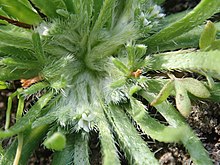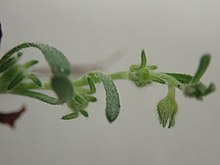Plagiobothrys plurisepaleus
Plagiobothrys plurisepaleus (common name - White rochelia)[2] is a species of flowering plant in the borage family.[1] It is native to Australia, being found in all mainland states: New South Wales, Queensland, Victoria, South Australia, Western Australia and the Northern Territory,[3] in moist areas in and around claypans.[4]
| Plagiobothrys plurisepaleus | |
|---|---|
 | |
| Flower | |
 | |
| Fruit | |
| Scientific classification | |
| Kingdom: | Plantae |
| Clade: | Tracheophytes |
| Clade: | Angiosperms |
| Clade: | Eudicots |
| Clade: | Asterids |
| Order: | Boraginales |
| Family: | Boraginaceae |
| Genus: | Plagiobothrys |
| Species: | P. plurisepaleus |
| Binomial name | |
| Plagiobothrys plurisepaleus | |
Description
The inflorescence is coiled in bud, but generally elongates in fruit. The pedicels are generally 0–1 mm, and the flower is bisexual with the sepals fused below the middle.[5]
Taxonomy
It was first described as Maccoya sepalea in 1859 by Ferdinand von Mueller,[1][6] but was assigned to the genus, Plagiobothrys, in 1928 by Ivan Murray Johnston.[7]
gollark: Well, yes, that's fair, in that it kind of mimics them.
gollark: ... so it's *not* like a real market?
gollark: If people detect what they think is a pricing error in the market, they can make money off it, providing incentives.
gollark: Because they get dividends based on how well it does.
gollark: That is the whole reason they work.
References
- "Plagiobothrys plurisepaleus". Australian Plant Name Index (APNI), IBIS database. Centre for Plant Biodiversity Research, Australian Government.
- "Flora of Victoria: Plagiobothrys plurisepaleus". vicflora.rbg.vic.gov.au. Retrieved 19 June 2020.
- "Plagiobothrys plurisepaleus". avh.ala.org.au. 19 June 2020. Retrieved 19 June 2020.
- "Plagiobothrys plurisepalus". FloraBase. Western Australian Government Department of Parks and Wildlife.
- "UC/JEPS: Jepson Manual treatment for PLAGIOBOTHRYS". ucjeps.berkeley.edu. Retrieved 19 June 2020.
- Mueller, F.J.H. von (1859). "Maccoya". Fragmenta Phytographiae Australiae. 1 (5): 127.
- Johnston, I.M. (1928). "I. Studies in the Boraginaceae - VII". Contributions of the Gray Herbarium of Harvard University. 81: 75.
External links
This article is issued from Wikipedia. The text is licensed under Creative Commons - Attribution - Sharealike. Additional terms may apply for the media files.